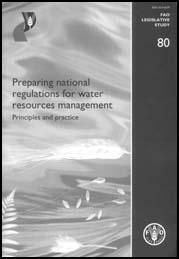
FAO LEGISLATIVE STUDY
80
Preparing national
regulations for water
resources management
Principles and practice
Stefano
Burchi
Ariella D’Andrea
for the
Development Law Service
FAO Legal Office
FOOD AND AGRICULTURE ORGANIZATION OF THE UNITED NATIONS
Rome, 2003